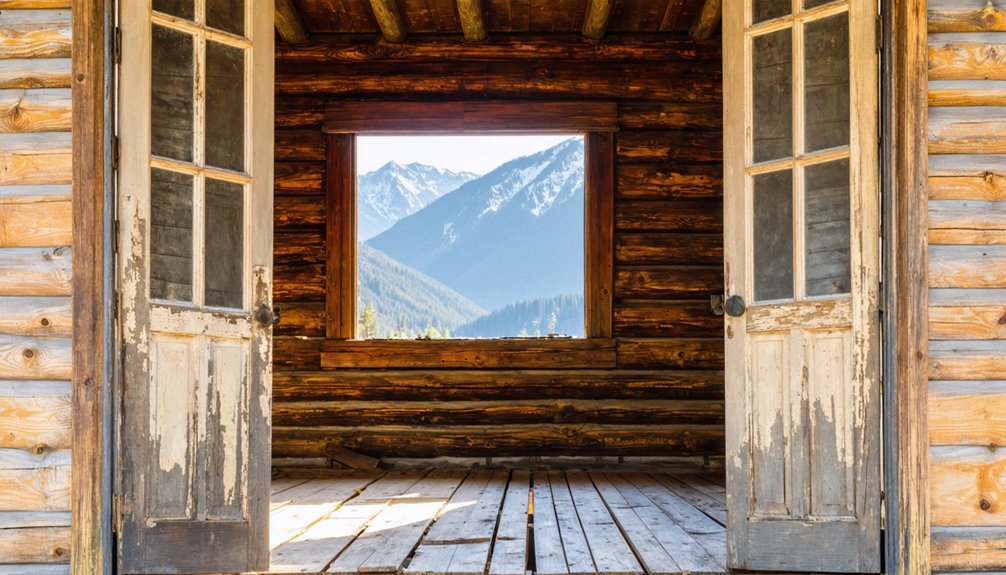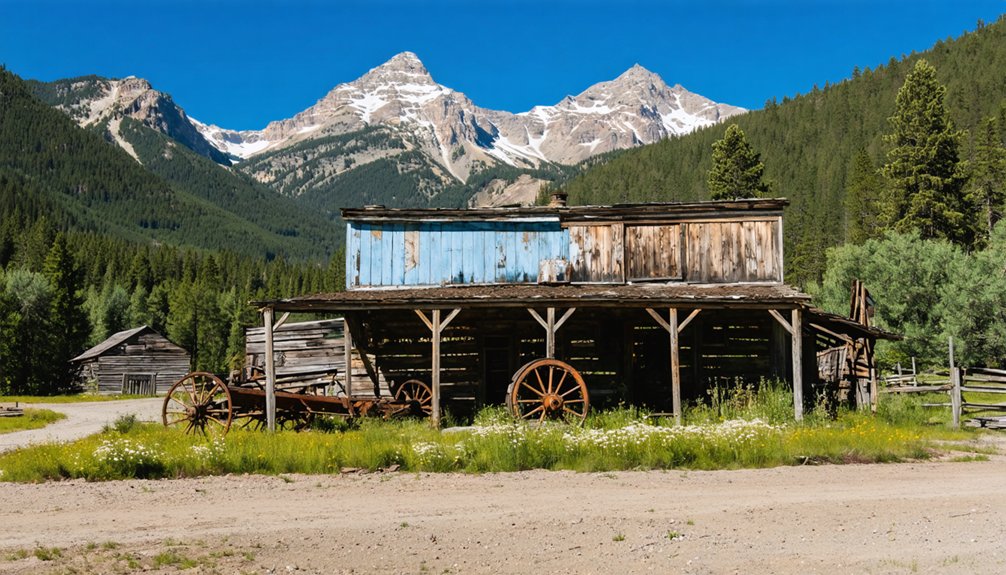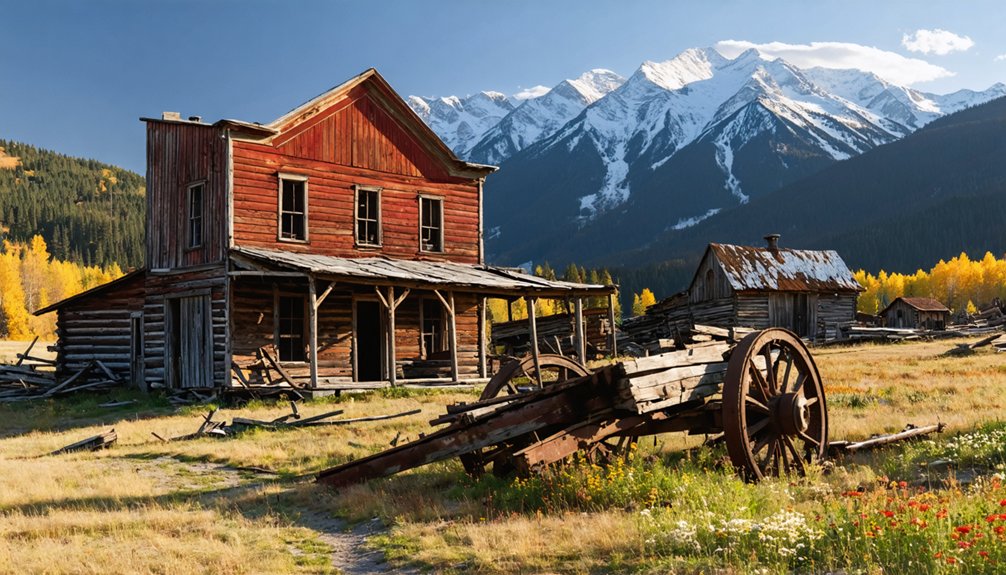You’ll discover Burgdorf Ghost Town at 6,000 feet in Idaho’s remote backcountry, where Fred Burgdorf established one of Idaho Territory’s earliest resort settlements in 1864. His 160-acre mountain meadow transformation featured therapeutic 113°F hot springs, a two-story lodge, and essential community services that thrived during the Thunder Mountain gold rush. After the mining boom waned and the Great Depression hit, this once-bustling resort gradually transformed into a preserved piece of pioneer history.
Key Takeaways
- Burgdorf became a ghost town after the Thunder Mountain gold rush decline, Fred Burgdorf’s retirement, and impacts from the Great Depression.
- Originally established in 1864, Burgdorf was a thriving resort settlement with a hotel, post office, and connections to neighboring towns.
- The site features historic hot springs at 113°F and original structures from the 1860s, listed on the National Register of Historic Sites.
- Visitors can explore authentic pioneer buildings, including an 1865 cabin, rustic log cabins, and ruins of the town’s original hotel.
- The ghost town maintains its remote frontier character through private ownership since 1870 and offers reservable hot spring soaking experiences.
The Legacy of Fred Burgdorf’s Settlement
Pioneer spirit and entrepreneurial vision converged when Fred Burgdorf, a German immigrant, established one of Idaho Territory’s earliest resort settlements in 1864.
You’ll find his legacy deeply rooted in the 160-acre mountain meadow he transformed from wilderness into a thriving community hub. After securing the government deed, Fred Burgdorf’s ambitious plans quickly materialized into a self-sufficient settlement complete with a hotel, post office, and fine family residence.
From untamed wilderness to bustling settlement, Burgdorf carved out 160 acres of Idaho history with determination and foresight.
The community impact of his endeavor reached far beyond the hot springs’ healing waters. The property remained a cherished destination after being purchased by James Harris in 1923.
Early mail delivery to the resort relied on rugged terrain crossings between McCall and Warren, requiring skilled carriers to navigate challenging mountain passes.
You can trace his influence through the daily stage services that connected Burgdorf to neighboring towns, the agricultural innovations that sustained year-round operations, and the European-inspired spa resort that drew visitors from across the Northwest.
His vision set the foundation for Idaho’s future resort communities.
Sacred Waters and Natural Hot Springs
While today’s visitors marvel at Burgdorf Hot Springs‘ crystal-clear waters, these sacred pools have drawn people to their healing depths since Fred Burgdorf’s 1870s discovery.
You’ll find the geothermal waters emerging at a steady 113°F, free from the sulfuric odors common in other hot springs. The mineral-rich sacred waters flow into three hand-crafted log pools, including the main communal bath and two smaller source pools. Modern families especially appreciate the partitioned shallow pool designed specifically for children. Advance planning is essential, as the springs are accessible by reservation only.
The springs’ healing properties extend beyond physical wellness – they offer a profound connection to Idaho’s pioneer heritage.
You’re soaking in the same waters where miners once sought relief, in pools built from timber that Burgdorf himself selected. Even now, the rustic facilities and natural setting preserve the authentic frontier experience, untouched by modern conveniences.
Mining Boom and Resort Development
You’ll find gold’s discovery in the late 1800s transformed Burgdorf from a quiet hot springs site into a bustling hub of mining activity and resort development.
Fred Burgdorf’s strategic acquisition of the hot springs in 1870 positioned him perfectly to capitalize on the Thunder Mountain gold rush of 1902, leading him to expand his hotel operations considerably.
The convergence of valuable mineral deposits, therapeutic hot springs, and Thunder Mountain miners seeking accommodations spurred Burgdorf’s growth into a vibrant commercial center that generated an estimated $500,000 in mining production during the Depression era.
The area’s mineral wealth included deposits of quartz vein gold near granite formations, which attracted numerous prospectors to the Leadville Mine and surrounding claims.
Gold Rush Sparks Growth
In 1864, the discovery of gold in Warren, Idaho triggered a transformative period that would shape Burgdorf‘s development for decades to come.
You’ll find that early prospectors had already established mining techniques along the Boise River Middle Fork by 1863, with Chinese operations later expanding to the surrounding ridges.
The area’s mining community dynamics evolved rapidly as discoveries near Burgdorf, including Shaw Mountain, delivered consistent yields for 15 years after 1864.
During this period, Fred Burgdorf recognized the financial potential of the natural hot springs and established one of Idaho’s first resort destinations.
You’d be amazed at how placer mining operations, using hydraulic giants and dredges, continued producing significant gold well into the 20th century. The Boise King dredge pulled in $200,000 between 1940-1942 and 1946, while Twin Springs generated $150,000.
Thunder Mountain Mining Impact
After the Caswell brothers reported gold in Thunder Mountain between 1895-1896, the remote wilderness area sparked one of Idaho’s most significant mining events.
You’ll find that early mining techniques focused on surface extraction due to the area’s brief two-week snowmelt season, limiting operations to simple sluicing methods.
The district’s economic challenges became apparent when Col. W.H. Dewey purchased the Caswell claims for $100,000 in 1901. While his Thunder Mountain Gold Mining and Milling Company attracted $5 million in capital, the staggering transportation costs of $125 per ton made profitable operation nearly impossible.
Despite thousands of prospectors flooding the region and establishing makeshift communities, the district’s total production reached only $350,000 by 1909. Below zero temperatures and extreme conditions forced many miners to travel four days to Warren just to obtain food supplies.
Today, digital collections preserve the photographs and documents that tell the story of Thunder Mountain’s mining history.
The harsh reality of Thunder Mountain’s isolation and difficult terrain ultimately proved too challenging for sustained success.
Hot Springs Meet Commerce
While Thunder Mountain’s mining prospects dimmed, Burgdorf Hot Springs emerged as a thriving commercial venture under Fred Burgdorf’s entrepreneurial vision.
You’ll find this remarkable economic transformation began when Burgdorf recognized the natural springs’ potential beyond their sacred Nez Perce origins. The tourism dynamics shifted as he strategically developed the site into a full-service resort, capitalizing on its location along popular mining routes. Today, visitors can explore remnants of this era at the Central Idaho Museum, which preserves artifacts from the region’s mining and resort history. The rustic cabins remain a testament to the original 1870 development of the property.
- Established a hotel and post office to serve the increasing flow of miners and travelers
- Renamed the area from Warm Springs to “Resort,” marking its new commercial identity
- Created infrastructure that attracted visitors seeking the springs’ therapeutic lithium-rich waters
- Positioned the establishment as a vital rest stop during the region’s mining boom
The resort’s success demonstrated how natural resources could fuel commerce beyond mineral extraction.
Historic Architecture and Preservation

Dating back to 1851, Burgdorf’s historic architecture stands as a remarkable indication of early Idaho frontier construction, featuring a distinctive two-story lodge with over 20 rooms and rustic log buildings scattered throughout the property.
You’ll find meticulous historic preservation throughout the site, which earned its place on the National Register of Historic Sites in 1972. The resort’s architectural integrity remains largely intact, from its eight-foot-wide fireplace with massive andirons to the uniquely crafted furniture incorporating nature’s knots.
The log-enclosed hot springs pools and original 1920s cabins continue to serve visitors, just as they did a century ago. Private ownership since 1870 has helped maintain the site’s authenticity, preserving its remote frontier character for future generations.
From Bustling Resort to Ghost Town Status
The story of Burgdorf’s transformation from thriving resort to ghost town begins with Fred Burgdorf, a gold miner who arrived in Idaho Territory around 1864.
You’ll find his legacy in the small hotel he built near the natural hot springs, modeling it after German spas. The resort flourished during the Thunder Mountain gold rush of 1902, serving as a vital waypoint for miners and travelers.
Key decline factors that led to Burgdorf’s ghost town transformation include:
The gradual decline of Burgdorf from vibrant resort to abandoned ghost town unfolded through a series of pivotal events and economic shifts.
- Janette Foronsard’s death in 1923, prompting Fred Burgdorf to sell and retire
- The waning Thunder Mountain mining boom, reducing visitor traffic
- Great Depression’s economic impact on regional commerce
- Steady deterioration of original buildings despite preservation efforts by subsequent owners
Today, you’ll discover Burgdorf as a historic relic, where echoes of its bustling past linger in weathered structures and therapeutic springs.
Modern-Day Adventures and Attractions

When you visit Burgdorf today, you’ll find yourself immersed in an authentic ghost town experience where you can soak in four natural hot spring pools, including one that’s nearly Olympic-sized with temperatures ranging from 100 to 113 degrees Fahrenheit.
You can explore the original 1865 cabin and other historic structures that have survived from the late 1800s, offering a tangible connection to Idaho’s mining era.
The well-maintained facilities include cozy wood-fired log cabins for changing and overnight stays, allowing you to experience the site much as visitors did over a century ago.
Soaking in Hot Springs
Visitors seeking therapeutic relaxation can discover three distinct geothermal pools at Burgdorf Hot Springs, each offering unique soaking experiences. The largest pool maintains a consistent 100°F temperature year-round, while two smaller source pools reach up to 118°F, providing enhanced thermal benefits.
You’ll find the natural aesthetic particularly appealing, with gravel bottoms and log-sided construction that preserves the site’s historic character.
- Reserve your two-hour session up to 90 days in advance
- Follow proper soaking etiquette by showering before entering
- Bring your own refreshments as there’s no food service on-site
- Consider nighttime soaking for spectacular stargazing opportunities
With a maximum of 20 people per session, you’ll enjoy a serene atmosphere that lets you fully embrace the therapeutic qualities of these mineral-rich waters.
Historic Buildings Today
Standing since 1865, Burgdorf’s original pioneer cabin anchors a remarkable collection of preserved frontier structures that transport you back to Idaho’s mining era.
Through careful historic preservation, you’ll discover authentic log cabins available for overnight stays, complete with period-appropriate amenities – meaning no electricity or running water.
The original general store and post office remain accessible for tours, while ruins of the town’s hotel add to the site’s genuine ghost town atmosphere.
Visitor engagement centers on immersive experiences in these rustic buildings, where you’ll rely on firewood for heat and shared outhouses for facilities.
At approximately $35 per adult, you can experience frontier life while exploring the cultural significance of one of Idaho’s earliest hot springs resorts, all within its pristinely maintained historical setting.
Frequently Asked Questions
Are There Any Documented Paranormal Activities or Ghost Sightings in Burgdorf?
Though this atmospheric time capsule sends chills down spines, you won’t find credible ghost encounters or paranormal investigations here. Historical records show no documented supernatural activity, just visitor’s eerie feelings.
What Wildlife Species Can Visitors Commonly Encounter Around the Resort Area?
You’ll spot deer, elk, and mountain bluebirds around the resort’s grounds. For wildlife photography and species identification, watch for black bears in surrounding forests and ospreys near water sources.
How Deep Are the Natural Hot Spring Pools at Burgdorf?
You’ll find yourself swimming in a 5-foot-deep main pool that’s as spacious as Neptune’s domain, while the children’s pool sits at 2 feet with gentler hot spring temperatures.
Is Camping Allowed Near the Historic Burgdorf Site?
You can’t camp directly at the historic site, but you’ll find regulated camping at the adjacent Burgdorf Campground. It’s first-come, first-served, with camping regulations limiting stays to 14 consecutive days.
What Happened to Fred Burgdorf’s Descendants After He Sold the Resort?
You won’t find clear records of the Burgdorf legacy after Fred’s departure in 1923. The family history goes quiet following his retirement to Weiser, with no documented descendants maintaining ties.
References
- https://history.idaho.gov/wp-content/uploads/2018/09/Burgdorf_72000441.pdf
- https://idgenweb.org/archives/history-ghost+towns.html
- https://idaho.for91days.com/burgdorf-hot-springs/
- https://idaho.for91days.com/category/ghost-mining-towns/
- https://visitidaho.org/travel-tips/boom-or-bust-exploring-idaho-ghost-towns/
- https://en.wikipedia.org/wiki/List_of_ghost_towns_in_Idaho
- https://www.allmccall.com/history_museums/historic_burgdorf.php
- https://visitidaho.org/things-to-do/ghost-towns-mining-history/
- https://www.ghosttowns.com/states/id/burgdorf.html
- https://idaho.idgenweb.org/Town History/burgdorf_history.htm



